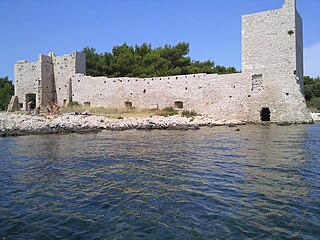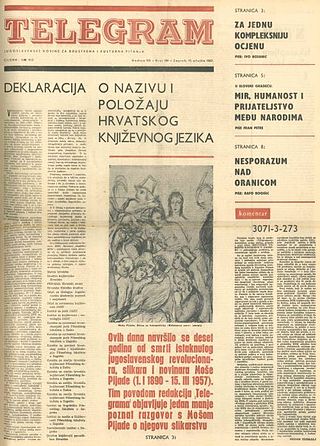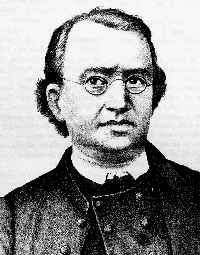
Zadar ( ZAH-dar, Croatian: [zâdar] ; historically known as Zara, is the oldest continuously inhabited city in Croatia. It is situated on the Adriatic Sea, at the northwestern part of Ravni Kotari region. Zadar serves as the seat of Zadar County and of the wider northern Dalmatian region. The city proper covers 25 km2 with a population of 75,082 in 2011, making it the second-largest city of the region of Dalmatia and the fifth-largest city in the country.

Premuda is a small island in Croatia, off the northern Adriatic coast. It belongs to the north Dalmatian islands which are situated north-west from the county center Zadar. Premuda is approximately 9 km (6 mi) long, up to 1.6 km (1.0 mi) wide, and has an area of 9.2 km2 (3.6 sq mi). It is situated southwest of Silba and northwest of Škarda and as such it is one of the outermost Adriatic islands from the perspective of the Croatian coastline.

Vir is an island on the Croatian coast of the Adriatic Sea with an area of 22 km2. It lies in Dalmatia, north of the city of Zadar. It is connected to the mainland via a road bridge. The main village on the island is the eponymous village of Vir. There are two more villages, Lozice and Torovi. According to the 2011 census, the island had a population of 3,000 inhabitants, making it the 13th most populous island in Croatia.
The Škabrnja massacre was the killing of 62 Croatian civilians and five prisoners of war by Serbian Autonomous Oblast Krajina Territorial Defence troops and the Yugoslav People's Army (JNA) in the villages of Škabrnja and Nadin east of Zadar on 18–19 November 1991, during the Croatian War of Independence. The massacre occurred shortly after an agreement to evacuate Zadar's JNA garrison following an increase in fighting between the Croatian National Guard and the JNA. Most of the killings were committed by SAO Krajina troops which followed the leading armoured JNA units fighting their way into Škabrnja on 18 November. During the initial attack, the attacking force employed a human shield of captured civilians forced to walk in front of armoured vehicles. Most of the civilian population fled the village and about 120–130 were captured by the JNA and detained in the village school and kindergarten. However, others who took shelter in basements were killed in or just outside their homes. A portion of those killed in the massacre were buried in a mass grave in Škabrnja, while dozens of bodies were turned over to Croatian authorities.

The Declaration on the Name and Status of the Croatian Literary Language is the statement adopted by Croatian scholars in 1967 arguing for the equal treatment of the Serbian, Croatian, Slovene, and Macedonian language standards in Yugoslavia. Its demands were granted by the 1974 Yugoslav Constitution.
The Battle of Zadar was a military engagement between the Yugoslav People's Army, supported by the Croatian Serb Serbian Autonomous Oblast of Krajina, and the Croatian National Guard, supported by the Croatian Police. The battle was fought north and east of the city of Zadar, Croatia, in the second half of September and early October 1991 during the Croatian War of Independence. Although the JNA's initial orders were to lift the Croatian siege of the JNA's barracks in the city and isolate the region of Dalmatia from the rest of Croatia, the orders were amended during the battle to include capturing the Port of Zadar in the city centre. The JNA's advance was supported by the Yugoslav Air Force and Navy.
Arbanasi is a community in the Zadar region, Croatia, of Albanian origin, who traditionally speak the Arbanasi dialect of Gheg Albanian. Their name is an obsolete way to say Albanians in Croatian and is the toponymy of the first Arbanasi settlement in the region, which today is a suburb of Zadar. In Albanian literature, they are known as "Albanians of Zadar".

Antun Pasko Kazali was a Croatian folk-writer, poet and translator. Born in Dubrovnik (Ragusa), he went to school in Dubrovnik, studying philosophy and theology in Zadar (Zara). He was a parish priest in Ošlje near Ston and chaplain in Šipan. As a parish priest, he often came into conflict with church authorities. He spent his most creative period in Zadar, starting in 1855. He was a professor at the gymnasium in Zadar, teaching Latin, Greek, and Croatian (1855–1861), and in 1862 became a professor at Rijeka/Fiume gymnasium. The last ten years of his life were spent in Dubrovnik.

Šime Vrsaljko is a former Croatian former professional footballer who played as a right-back.

D407 branches off to the southwest from D8 in Zadar towards Zadar ferry port - ferry access to Preko, Ugljan Island (D110), Brbinj and Sali, Dugi otok (D124), as well as Ancona, Italy. The road is 3.8 km (2.4 mi) long.
Zaton Obrovački is a village in the municipality of Jasenice, Zadar County, in Croatia.
Dalibor Zebić is a Croatian professional football manager and former player.
Tornado Zadar is a supporter group from Zadar, Croatia. The official name of this civil association is in Croatian Udruga navijača Tornado Zadar, which translated means Civil association of the supporters Tornado Zadar. The association is registered with the Croatian NGO register under the number 13000768.
Igor Marenić is a Croatian professional sailor. Competing in the 470 class with Šime Fantela, he won gold at the 2016 Summer Olympics, the 2009 World Championships, and three European Championships.
Marcel Heister is a German footballer who plays as a defender for Ludogorets Razgrad in the Bulgarian First League.

Antonio Mršić is a Croatian professional footballer who currently plays as a midfielder for Turkish club Ümraniyespor.

Monument to the Sun or The Greeting to the Sun is a monument in Zadar, Croatia dedicated to the Sun. It consists of three hundred, multi-layered glass plates placed on the same level as the stone-paved waterfront. It consists of a 22-meter diameter circle, with photovoltaic solar modules underneath. Lighting elements installed in a circle turn on at night, and produce a light show. The monument, designed by Croatian architect Nikola Bašić, symbolizes communication with nature, communicates with light, while the nearby Sea organ communicates with sound.

The Mayor of the City of Zadar is the highest official of the Croatian city of Zadar. From 1990 to 2007 the mayor was elected by the city assembly. Since 2007 Croatian mayors are elected directly by the citizens. The first such election in Zadar occurred in 2009.










